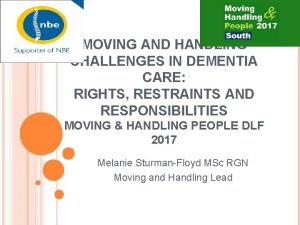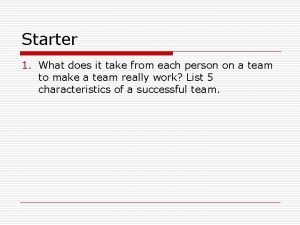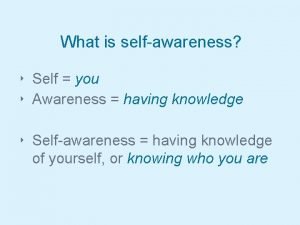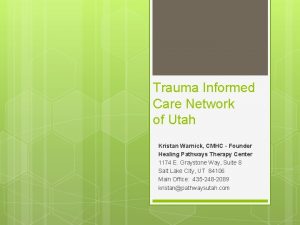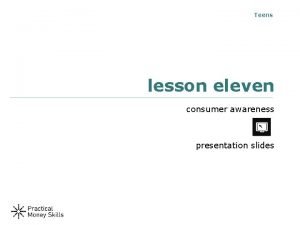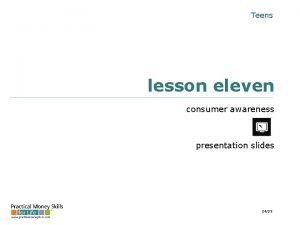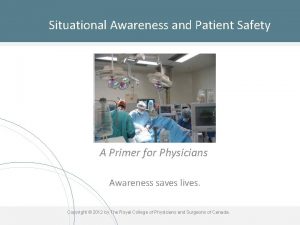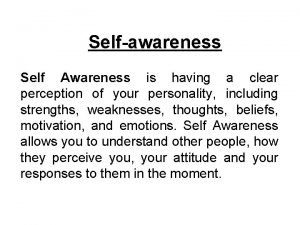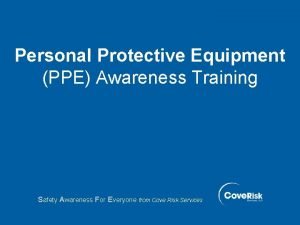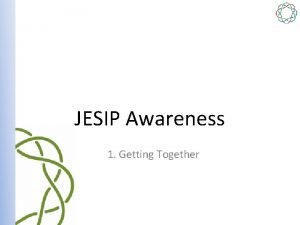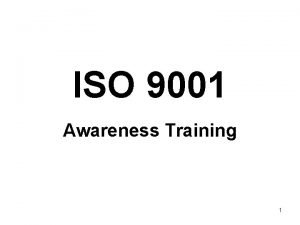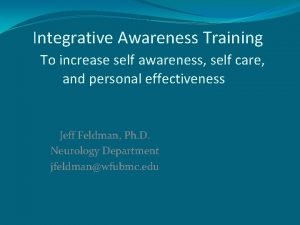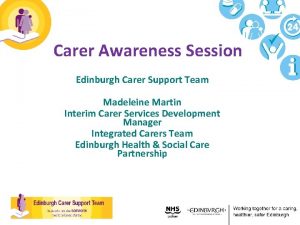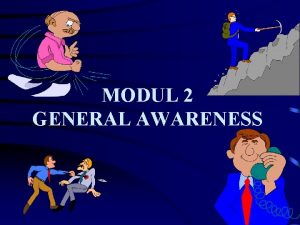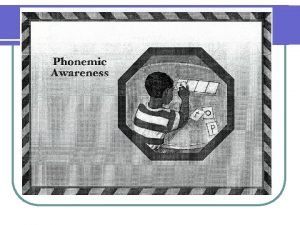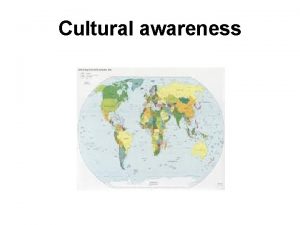Carer Awareness in General Practice CARER AWARENESS IN






















































- Slides: 54

Carer Awareness in General Practice

CARER AWARENESS IN GENERAL PRACTICE PART 1: Recognition of the carer role

Who is a carer? Carers can provide care for a person who: • • has a disability has a mental illness has an ongoing medical condition or is an older person with care needs. Carers do not: • • need to live with the person they care for need to be the main source of care and support have to provide care every day or over many years have to receive the Carer Payment or Allowance from Centrelink.

Who is a carer? Continuous Care 24 -hour support and aid to someone with high care needs Intermittent Care for individuals who are mostly independent

Who is a carer? About 1 in 8 people in Australia are carers 2. 6 M+ Australians

Who is a carer? People become carers in different ways It can happen gradually as a person’s health and independence get worse over time, or it can happen suddenly after a health crisis or accident. It is important not to confuse carers with paid care workers, such as community or aged care workers.

Tips for identifying carers in your practice • Include questions on your registration form • Consider patients who are – frail and elderly, – have dementia, – a mental illness, – a disability, – chronic illness or complex needs, – or receive palliative care • First appointment for patients with longer-term illness • Use practice management software or other information systems • Record a carer in both the patient and the carer’s file.

Tips for identifying carers in your practice • Ask patients open questions about the support they provide • Carer may change over a patient’s lifetime • Every carer situation is different.

Issues faced by carers • Physical and mental health and wellbeing • Social impacts • Financial hardship

Tips for supporting carers in your practice Checklists MBS Items Influenza vaccination Safety net Psychological distress

Tips for supporting carers in your practice • • • Financial impact of services Views of carers and the barriers they face A carer’s health Carers under the age of 25 Potential abuse

QUESTIONS?

CARER AWARENESS IN GENERAL PRACTICE PART 2: Identifying and supporting carer needs

Working with carers to support their needs According to the Carers Recognition Act 2012, a carer should: • • • be respected and recognised be supported have their views and cultural identity taken into account have their social wellbeing and health taken into account consider the effect of being a carer on their participation in employment and education.

Working with carers to support their needs Opportunities to identify and support carer needs will vary depending on whether they are also your patient. • Consider whole-practice opportunities to identify carer needs • Create opportunities to see them independently of patient • Offer flexibility to carers to attend for their own appointments • If the carer is a patient at a different practice, it is still important to check in and ask if they are receiving the support they need.

Carers in Aboriginal and Torres Strait Islander communities Aboriginal and Torres Strait Islander people are more likely to be carers than non-Indigenous Australians.

Carers from culturally and linguistically diverse communities (CALD) People from CALD communities may not understand the concept or identify with the term ‘carer’ as caring for family members can be a strong part of the culture. Additional barriers include: • language and communication difficulties • lack of knowledge or understanding of the mainstream health care system • inadequate access to culturally safe services.

Carers in LGBTIQ communities Carers in the LGBTIQ community can face invisibility, discrimination or exclusion. Many LGBTIQ carers may be isolated from others in their communities by: • social isolation • distance • financial disadvantage • stigma or fear of discrimination • demands related to their role • limited access to affordable inclusive services.

Carers in LGBTIQ communities The caring role might be particularly challenging for LGBTIQ carers because of: • discrimination • fear of exposure or judgement • loss of contact with family/culture • lack of social and legal recognition of relationships and ‘family of choice’ • invisibility in caring situations • inability to maintain intimate relationships or to ‘be themselves’ in care situations.

Tips for a carer-friendly practice • Physical accessibility • Consultations at times when their caring duties permit • After-hours medical support • Feedback from carers on your systems and processes • Safety-netting and follow-up arrangements

Tips for a carer-friendly practice • Take home notes for patient and carer • Same GP / Health professional • Examine barriers to carer support and ways in which they could be overcome within your field of practice • Interpreters for patients and carers who are not fluent in English • Information pack for carers and family members

Referral pathways for carers • • • Health. Pathways Carer counselling services Mental health services Respite services Peak bodies Peer support

Referral pathways for carers • Respite services • Peak bodies • Peer support

Life after caring Every caring experience is different as is how an individual will cope after caring duties have finished. Some problems commonly seen when carers stop caring include: • feelings of emptiness • loneliness • low self-esteem • depression • anxiety.

Life after caring • • • Death of the care recipient may result in a sense of shock, even if the person has been ill for a long time. Carer payments often come to an end within a few weeks of death and there may be housing issues if the person who has died owned or was leaseholder for a joint home. Admission into residential care also results in a sense of bereavement. The carer may experience feelings of guilt and anxiety, even though the move is often the only feasible option. Even though the carer will continue to be a carer, albeit from a distance, they may feel a sense of failure.

Life after caring Varying care needs may result in carers moving in and out of a caring role For example, where a family member misuses alcohol or drugs, has a mental health issue or an eating disorder, carer responsibilities will vary according to the current state of health of the person they care for. Even when that person appears to be coping well, the carer might always have the stress of wondering what the future will bring and uncertainty of not knowing when their help will be needed urgently.

QUESTIONS?

CARER AWARENESS IN GENERAL PRACTICE PART 3: Involving the carer in patient care

Carers as partners in care Involving carers and listening to their views when devising a care plan is likely to result in much better co-operation and effective implementation.

Carers as partners in care Privacy and Confidentiality

Carers as partners in care What to do when your patient is reluctant for their information to be shared?

Carers as partners in care What to do when the patient lacks the mental capacity to make a decision about sharing of information?

Tips for incorporating carers in care treatment and planning Talk to carers and other family members. Adopt a problembased approach with carers. Use medical records and information tools. Include the carer in multidisciplinary case conferences.

Tips for incorporating carers in care treatment and planning • Actively involve carers in the planning and implementation of long-term management plans. • Develop holistic and shared decision-making approaches to treatment plans with patients and carers. • Co-ordinate and integrate the agendas of carers and other family members with that of the patient and your own agenda. • Enable shared decision-making and agree on management plans. • Recognise that carers may need different information and support depending on where they are on their caregiving journey.

Working with carers of people with a mental illness Families and carers should be: • • • recognised, respected and supported as partners in providing support and care to consumers identified and engaged as soon as possible in assessment, treatment, care and recovery engaged in organisational practice and governance. Services must have: • • clear processes and practices that support open communication with consumers, families and carers regarding information sharing, privacy and confidentiality regard for the impact of mental illness on family members and to assist families and carers to identify their needs, including in relation to the caring role.

Working with carers of people with a mental illness Privacy preferences vs keeping family members informed Victoria’s Mental Health Act 2014 Carers need information to assist them in their caring role and authorises clinicians to provide this information in specified circumstances Openly communicating with patients, families and carers about privacy, confidentiality and information sharing is fundamental.

Working with carers of people with a mental illness Consumers have the right to privacy and should have the opportunity to decide what information can be shared with their families and carers. • • • The Mental Health Act 2014 includes specific obligations for clinicians to consult with and inform carers where actions will directly affect the carer and the care relationship. Details of these obligations and when they apply can be found in the Chief Psychiatrist’s guideline. Providing general information and hearing from a carer or family member does not breach privacy or confidentiality.

Medical decision making when a patient cannot consent A patient must be an adult, and able to understand, retain, use or weigh up information about the general nature and effect of the proposed medical treatment and communicate their decision to consent to the treatment. • • • The Medical Treatment Planning and Decisions Act 2016 provides a framework for making medical treatment decisions when people do not have capacity to make their own decisions. The Act allows people to complete an advance care directive, appoint a medical treatment decision maker, and appoint a support person. The Act also sets out the process for health practitioners when a patient does not have decision-making capacity to consent to medical treatment.

Medical decision making when a patient cannot consent A person may only create an advance care directive if they have decision-making capacity in relation to each statement in their advance care directive. There are two forms of statement a person may include in their advance care directive: • an instructional directive • a values directive. If medical treatment is clinically indicated and a person does not have decision-making capacity, a health practitioner must obtain consent through an instructional directive, or if there is none, obtain consent from a medical treatment decision maker.

Medical decision making when a patient cannot consent The medical treatment decision maker will be the first willing and available person from the list below: • an appointed medical treatment decision maker (appointed by the • • adult when they have decision-making capacity) a guardian appointed by VCAT the first of the following with a close and continuing relationship with the person: – – – the spouse or domestic partner the primary carer of the person the first of the following and, if more than one person fits the description in the subparagraph, the oldest of those persons: • an adult child of the person • a parent of the person • an adult sibling of the person.

QUESTIONS?

CARER AWARENESS IN GENERAL PRACTICE REFERRAL PATHWAYS AND RESOURCES

Referral pathways and resources • • Health. Pathways Mental health services for carers – Carer Gateway counselling service counselling. carergateway. gov. au – Carers Victoria counselling service carersvictoria. org. au/resources/counselling • • • Respite services My Aged Care NDIS Resources for general practice Resources to support carers

CARER AWARENESS IN GENERAL PRACTICE CASE STUDIES

Examples of the diversity of carers Amanda is 36 a single mum and her father has cancer. He is a widower so Amanda is trying to juggle work, looking after her daughter and providing practical and emotional support for her father who lives 100 kilometers away. Omar is 62 and has rheumatoid arthritis. His wife has just been discharged home from hospital following a stroke. Amy is 14 Her mother has multiple sclerosis. Her father has given up work to look after her mother but relies on Amy to give him a break and help out when she comes home from school. Paul is 27 and lives with his partner, Michael, who has bipolar disorder. They receive no support from either of their families, and Paul is not comfortable disclosing his relationship to his employer so does not feel he can access carer’s leave.

Case study – Aisha is 20 years old. The last time she was seen in your practice was nearly 4 years ago, even though she has been registered with you for over 10 years. Aisha comes into the appointment very tearful. She tells you that she is struggling to cope with university and looking after her mother who is disabled following a head injury two years previously. Her mother is also registered with your practice, but you do not see her frequently either, and you were under the impression that she was largely self‐caring. What are some ways you might help Aisha?

Case study – Aisha continued There are many ways you can help Aisha. Here are just a few suggestions: • • • Record that Aisha is a carer on her file Record that Aisha is a carer on her mother’s file Find out exactly what Aisha is doing for her mother – does her mother need further medical assessment or additional care? Consider bulk-billing Aisha’s appointments Provide Aisha with information about being a carer and supports available for carers.

Case study – Aisha continued There are many ways you can help Aisha. Here are just a few suggestions: • • • Provide Aisha with information about the NDIS and organisations supporting people with acquired brain injury Monitor Aisha's low mood through regular review appointments, provide a mental health plan, medication and/or referral, as appropriate Suggest that Aisha speak to her university about the problems she is having with her studies and the reasons for this.

Case study – Linda is 64 and has terminal breast cancer. She is losing weight and becoming more and more reliant on her partner, Julie. They have been together for 6 years and Julie is very supportive and clearly cares for Linda. During a routine review, you ask Linda if you can share her medical information with Julie but she refuses. How might you approach this situation?

Case study – Linda continued There are many ways you could approach this situation. Here is one scenario: • • • It is important to establish the reasons why Linda does not want to share her medical information with Julie. You discuss with Linda the benefits of sharing medical information with Julie to enhance her care. Linda responds that she understands the reasons for sharing her information and would like Julie to be involved in her care. However, Linda has not told Julie about a string of overdoses she took when she was in an abusive relationship in her 20 s. She feels very embarrassed about these episodes and does not want Julie to know about them.

Case study – Linda continued There are many ways you could approach this situation. Here is one scenario: • • You explain to Linda that it is possible to only share information with Julie about her cancer and the care that she needs currently, without allowing access to any information about Linda’s past medical history. Linda welcomes this suggestion. Written and signed confirmation is supplied by Linda and a notice put on her medical record to this effect.

Group discussion What are some case studies or scenarios you might see in your practice?

Supported by the Victorian Government and Carers Victoria

 Carer
Carer Moving and handling dementia patients
Moving and handling dementia patients Carer
Carer Leader doer thinker carer
Leader doer thinker carer Leader doer thinker carer
Leader doer thinker carer Privacy awareness and hipaa awareness training cvs
Privacy awareness and hipaa awareness training cvs Diferencia entre gran plano general y plano general
Diferencia entre gran plano general y plano general Where did general lee surrender to general grant?
Where did general lee surrender to general grant? Aice general paper practice test
Aice general paper practice test Aice general paper essay example
Aice general paper essay example Uil science practice tests
Uil science practice tests Family medicine def
Family medicine def Practice assessor and practice supervisor
Practice assessor and practice supervisor Iso 9001:2015 awareness training ppt
Iso 9001:2015 awareness training ppt Why is self-awareness important
Why is self-awareness important Trauma awareness and treatment center utah
Trauma awareness and treatment center utah Metalinguistic awareness
Metalinguistic awareness Metalinguistic awareness
Metalinguistic awareness Lesson eleven quiz consumer awareness
Lesson eleven quiz consumer awareness Lesson eleven consumer awareness
Lesson eleven consumer awareness Kpis de awareness
Kpis de awareness Elaine bromiley case
Elaine bromiley case Is having a clear perception of your personality
Is having a clear perception of your personality Security training and threat awareness
Security training and threat awareness Level 3 cjis security test
Level 3 cjis security test Phoneme substitution
Phoneme substitution Abuse prevention training quiz answers
Abuse prevention training quiz answers Contingency awareness
Contingency awareness Phonemic awareness continuum
Phonemic awareness continuum Phonemic awareness definition
Phonemic awareness definition Prephonemic stage
Prephonemic stage Ppe awareness training
Ppe awareness training Ppe awareness training
Ppe awareness training Arctic domain awareness center
Arctic domain awareness center Objective for mental health awareness
Objective for mental health awareness Poem on mental health awareness day
Poem on mental health awareness day Ultrasound awareness month
Ultrasound awareness month Committmebt
Committmebt Jesip app
Jesip app Positive physical approach
Positive physical approach Sogedac
Sogedac Iso 9001 awareness training
Iso 9001 awareness training Iso 14001 2015 awareness training
Iso 14001 2015 awareness training Internal audit awareness presentation
Internal audit awareness presentation Integrative awareness
Integrative awareness Reportable behavioral indicators
Reportable behavioral indicators Potential insider threat indicators cyber awareness
Potential insider threat indicators cyber awareness Define security education
Define security education Non obvious relationship awareness
Non obvious relationship awareness Perbedaan awareness dan consciousness
Perbedaan awareness dan consciousness Syntactic awareness activities
Syntactic awareness activities Hazwoper
Hazwoper Environmental management system awareness training
Environmental management system awareness training Cold storage
Cold storage Test your awareness whodunnit answers
Test your awareness whodunnit answers

